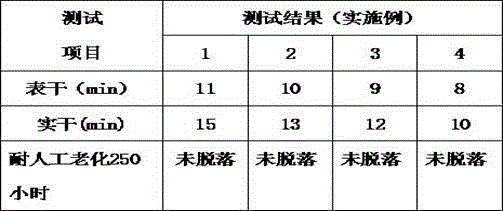Water-borne acrylic primer and preparation method thereof
A water-based acrylic and acrylic resin technology, used in coatings, anti-corrosion coatings, epoxy resin coatings, etc., can solve problems such as chemical resistance, poor weather resistance, affecting coating film performance, and not participating in cross-linking reactions. Achieve better yellowing resistance, low cost and improved quality
- Summary
- Abstract
- Description
- Claims
- Application Information
AI Technical Summary
Problems solved by technology
Method used
Image
Examples
Embodiment 1
[0027] The water-based acrylic primer of the present invention comprises the following components in parts by weight: 35 parts of silicone modified acrylic resin, 15 parts of amino resin, 2 parts of titanium dioxide, 9 parts of methyl propylene glycol, 5 parts of bentonite, 7 parts of ethanolamine , 12 parts of polyoxypropylene glyceryl ether, 4 parts of sodium dodecylbenzenesulfonate, and 20 parts of deionized water.
[0028] The preparation process steps are as follows:
[0029] (1) Weigh the materials in the raw material formula by weight fraction;
[0030] (2) Add silicone-modified acrylic resin, amino resin, and deionized water into a reaction kettle with a stirring device, heat up to 50°C, stir at a speed of 200 rpm, and stir for 1 hour;
[0031] (3) After the solid is completely dissolved, add ethanolamine, adjust the pH to 7, then raise the temperature to a reaction temperature of 70°C, stir at a speed of 300 rpm, and stir for 1 hour; then, add the rest of the raw mat...
Embodiment 2
[0033] The water-based acrylic primer of the present invention comprises the following components in parts by weight: 25 parts of epoxy modified acrylic resin, 25 parts of amino resin, 8 parts of titanium dioxide, 3 parts of methyl propylene glycol, 15 parts of zinc phosphate, 2 parts of ammonia water 4 parts, 4 parts of polyoxypropylene polyoxyethylene glyceryl ether, 10 parts of sodium cetylbenzenesulfonate, 30 parts of deionized water.
[0034] The preparation process steps are as follows:
[0035] (1) Weigh the materials in the raw material formula by weight fraction;
[0036] (2) Add epoxy-modified acrylic resin, amino resin, and deionized water into a reaction kettle with a stirring device, heat up to 70°C, stir at a speed of 400 rpm, and stir for 3 hours;
[0037] (3) After the solid is completely dissolved, add ammonia water, adjust the pH to 8, then raise the temperature to a reaction temperature of 90°C, stir at a speed of 500 rpm, and stir for 2 hours; then, add th...
Embodiment 3
[0039] The water-based acrylic primer of the present invention comprises the following components in parts by weight: 30 parts of polyester modified acrylic resin, 19 parts of amino resin, 5 parts of titanium dioxide, 6 parts of methyl propylene glycol, 9 parts of silicon dioxide, ethanolamine 4 parts, polydimethylsiloxane 8 parts, polysorbate 7 parts, deionized water 25 parts.
[0040] The preparation process steps are as follows:
[0041] (1) Weigh the materials in the raw material formula by weight fraction;
[0042] (2) Add polyester-modified acrylic resin, amino resin, and deionized water into a reaction kettle with a stirring device, heat up to 60°C, stir at a speed of 300 rpm, and stir for 2 hours;
[0043] (3) After the solid dissolves completely, add a pH regulator to adjust the pH to 7, then raise the temperature to a reaction temperature of 80°C, stir at a speed of 400 rpm, and stir for 1.5 hours; then, add the rest of the raw materials, and stir at a speed of 500 ...
PUM
 Login to View More
Login to View More Abstract
Description
Claims
Application Information
 Login to View More
Login to View More - R&D
- Intellectual Property
- Life Sciences
- Materials
- Tech Scout
- Unparalleled Data Quality
- Higher Quality Content
- 60% Fewer Hallucinations
Browse by: Latest US Patents, China's latest patents, Technical Efficacy Thesaurus, Application Domain, Technology Topic, Popular Technical Reports.
© 2025 PatSnap. All rights reserved.Legal|Privacy policy|Modern Slavery Act Transparency Statement|Sitemap|About US| Contact US: help@patsnap.com

